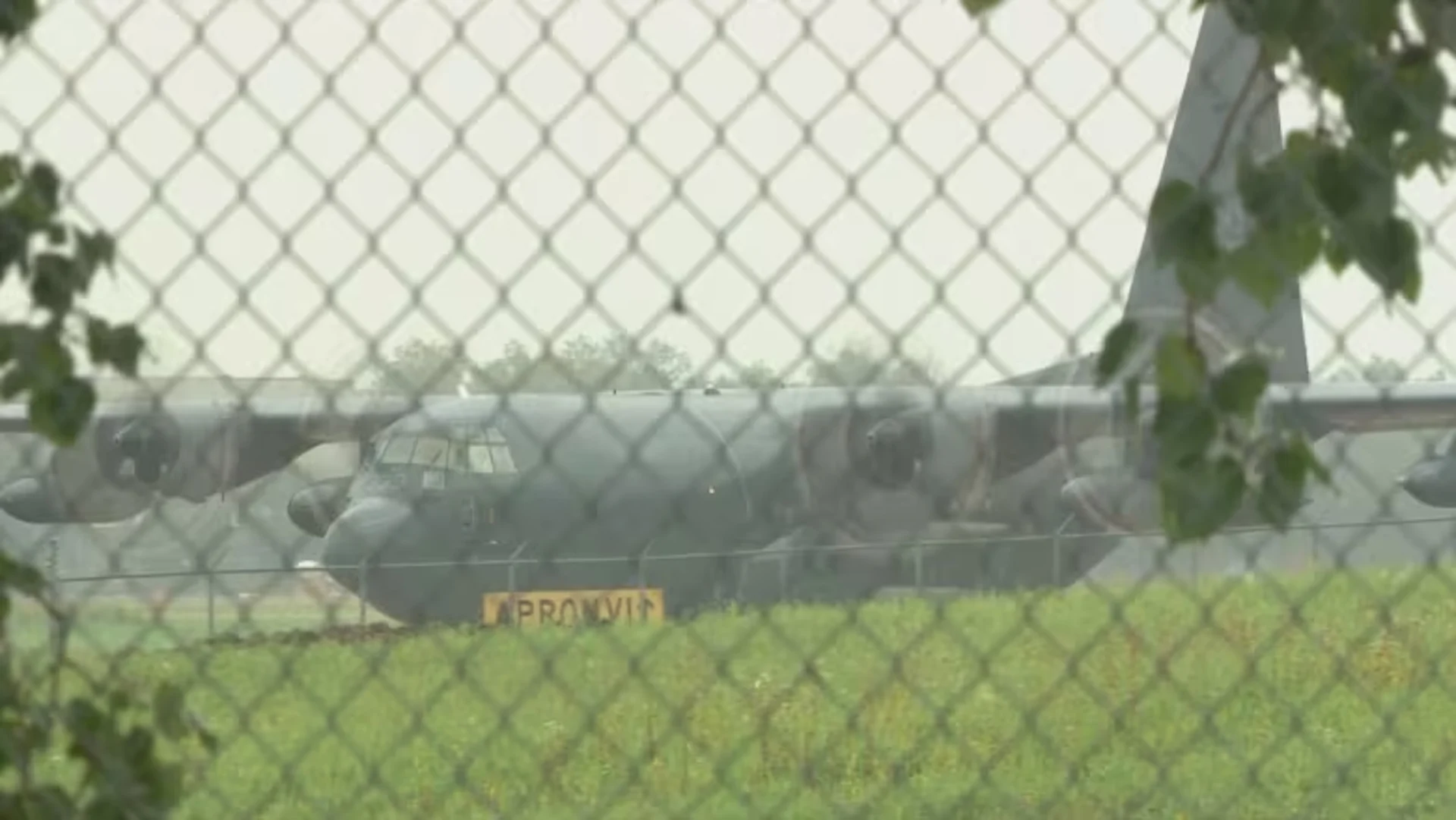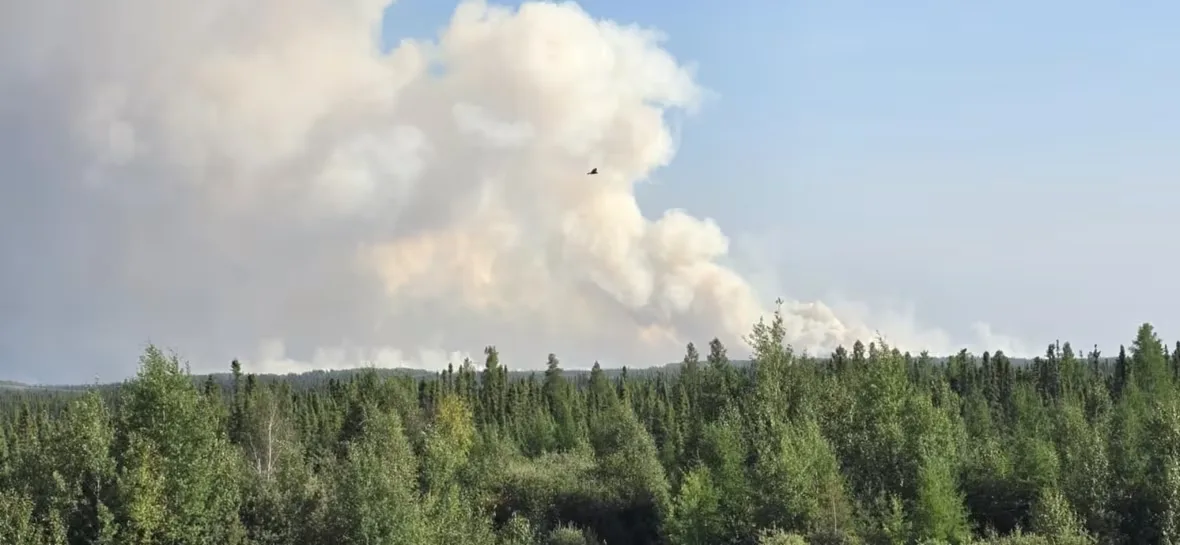
Evacuations continue in Bunibonibee Cree Nation as rain helps slow wildfire
Crews are hoping to seize on a stretch of rainy, overcast weather to evacuate a remote Manitoba First Nation before an approaching wildfire gets any closer, an official with the Manitoba Wildfire Service says.
Evacuation flights from Bunibonibee Cree Nation started taking off Wednesday morning, with thousands of evacuees being relocated to Winnipeg, Brandon and Thompson as a raging wildfire burning out of control encroaches on the fly-in community in northeastern Manitoba.
Those flights happened after the province's wildfire service became "very concerned" a couple of days ago about a blaze that's now burning about 10 kilometres from the First Nation, which predictions indicated could move about seven kilometres in a day.
Wildfire director Earl Simmons said the remoteness of the community, which has no road or rail access, makes evacuation difficult — and smoky conditions from wildfires can make it too difficult to see for aircraft to fly.
So when favourable weather conditions in the last few days helped stall the fire's progression, including about 15 millimetres of rain that fell in the community overnight and a little less than that on the fire itself, Simmons said crews wanted to take advantage of the chance for a safe, controlled evacuation without making people panic.
DON'T MISS: Blazing Arctic temperatures continue to feed fires in Canada's north
"We'll do the best we can to take advantage of the break in the weather, and see what we can do to try to corral that fire," Simmons said Thursday. "But the predicted weather going forward, it's going to be challenging for the firefighters on that fire."

A military Hercules plane takes off from Winnipeg's airport to help with evacuations at Bunibonibee Cree Nation, about 577 kilometres to the north. (Travis Golby/CBC)
Thousand evacuees leaving Thursday
Bunibonibee Cree Nation Chief Richard Hart previously said anywhere between 2,700 to 3,000 people live in the community at this time of the year — all residents — but a few who are staying back to look after critical infrastructure and assist with emergency response are slated to be evacuated in the coming days.
At least 850 residents were relocated on Wednesday, Hart told CBC news.
Marlene Grieves was among them. The Bunibonibee Cree Nation resident boarded one of the Hercules planes assisting with the evacuation to Thompson on Wednesday, amd from there she flew to Winnipeg where she is currently waiting for the rest of family including her husband, children and grandchildren to join her.
"I'm just scared about them, all that smoke and fire too," Grieves said. "I am just praying nothing is going to happen to them."
Grieves has been forced out of her home before. She remembers being evacuated in 1989 due to wildfires. But Grieves said this is the first time she has seen a wildfire this size get so close to her community.
"I don't know how to say I was scared," she said. "This is the first time I see that much smoke."

The wildfire that has forced a full-scale evacuation from Bunibonibee Cree Nation continues burning out of control, stretching around 6,000 hectares by Aug. 15 (Submitted by Doris Canada)
As of the last official update from the province's website on Tuesday, the fire had grown to 5,747 hectares — though Simmons said it's likely over 6,000 hectares by now. As of that most recent update, there were 71 total fires burning across Manitoba, including several that were out of control.
Simmons said as the wildfire service continues to face challenges right across northern Manitoba, the province is putting out a call for more firefighters from other parts of Canada and the United States to help, in addition to the 10 firefighters from Minnesota and Wisconsin already stationed in the province.
With more hot, dry weather expected after Friday, and concerns about winds pushing the wildfire into Bunibonibee, formerly known as Oxford House, Simmons said crews know it will "take no time for that fire to become very active again."
"There's a lot of work to be done there. So we're going to do our best to try and prevent that fire from growing in size," he said, adding that while the fire near the community was caused by lightning, several others across the north in recent days were caused by people.
"We're stretched very thin and all of Western Canada is, in fact. So we can't afford to have any extra fires."
A spokesperson for Indigenous Services Canada said though the Canadian Red Cross is leading the evacuations on the ground, the federal agency is "closely monitoring the situation" and has 24/7 duty officers in place to support any First Nations needing assistance.
Bunibonibee Cree Nation is about 577 kilometres north of Winnipeg, and about 185 kilometres southeast of Thompson.
The Red Cross is also supporting the partial evacuation of Nisichawayasihk Cree Nation and Tataskweyak Cree Nation. Residents with health issues were being relocated from both communities Wednesday due to wildfire smoke.
This article with files from Meaghan Ketcheson and Gavin Axelrod was originally published by CBC News.









